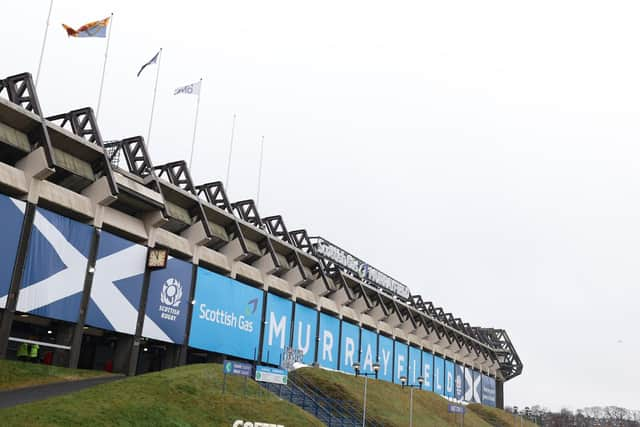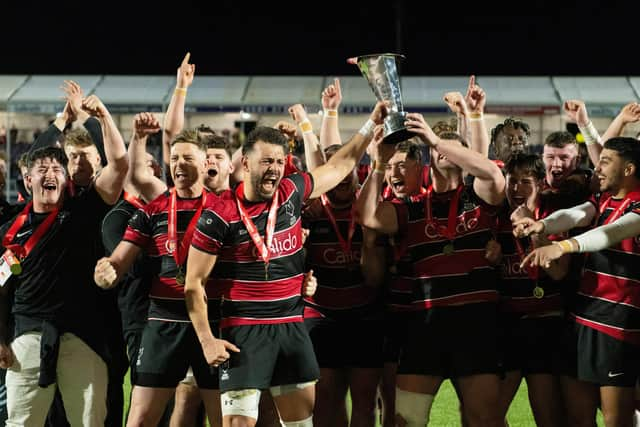A-teams at heart of Scottish Rugby’s new top-five vision as Super Series is ditched
Around 200-plus semi-pro players will be asking that very question this morning as they ponder their next move. The governing body is saying the decision has been made “not from a financial perspective” but with a £10 million hole in its finances you could be forgiven for being cynical.
The Super6 was launched five years ago by SRU chief executive Mark Dodson with the aim of bridging the gap between club rugby and the professional game. Neither Dodson nor one of its chief architects, Jim Mallinder, was at Murrayfield on Thursday to explain why it was being consigned to the dustbin of history. Understandable perhaps because both men will be gone by the summer so it was left to Stevie Gemmell, Al Kellock and Keith Wallace to explain the reasoning behind the decision.
Advertisement
Hide AdAdvertisement
Hide AdGemmell, Scottish Rugby’s technical and operations director, Kellock, the Glasgow Warriors MD, and Wallace, the union’s vice-president, are all part of a steering group established to come up with a new “performance pathway” for the male game in this country. The group, led by Gemmell, also includes Dodson and outgoing performance director Mallinder along with John McGuigan, chair of Scottish Rugby Ltd, Colin Rigby, the SRU president, and Gav Scott, the director of rugby development.


Together with input from Scotland head coach Gregor Townsend, they have come up with a plan whose bold aim is to return the national side to the top five in the world rankings and keep them there for the next decade. Scotland are currently ranked eighth but were fifth going into last year’s Rugby World Cup.
What’s the plan and how will it work?
At its core is a focus on developing more home-grown players and, by definition, one has to assume the aim is to be less reliant on imports. Around half the current national squad was born outside Scotland but it is hoped that “a better alignment between the domestic and professional game” can produce more native talent.
A key plank of this is the reinstatement of Scotland A fixtures which will be scheduled away from URC weekends and will allow young talent and players on the periphery of Townsend’s squad to have exposure to international games. If it feels a little bit ‘back to the future’ that’s because it is. A-team fixtures used to be a staple of Five and Six Nations weekends, usually played on the Friday night. Scotland will look to reinstate games against second string teams from the likes of England and Ireland but also aim to play countries like Portugal and Chile who made such an impression at the recent World Cup.


A-teams can work for Glasgow and Edinburgh too
A-team games for Scotland’s two professional teams are also on the agenda. Kellock envisages 10 matches per season for both Glasgow and Edinburgh’s reserve sides, with the opposition being provided by URC rivals, some English Premiership sides, Italian clubs and some French teams.
“We’ve got to have competitive games – there is no point having games that don’t move our players forward – but we’re confident that there is enough interest out there to get a good and high levels of teams,” said Kellock.
Ultimately, Kellock would like to see an A-team league but the immediate focus is on players “playing up” more often, ie challenging themselves against better opposition.
Copy Irish with more investment in pro team academies and players staying longer
The pathway plan also recommends expanding the academies at Glasgow and Edinburgh and, crucially, keeping players there longer, allowing them more time to develop. The academies will work with players right through to the under-23 age bracket and “deliver appropriate level game time”.
Advertisement
Hide AdAdvertisement
Hide Ad“We also want to be creating more opportunities for our academy players to be playing pro level,” said Kellock. “Ireland are exceptionally good at getting their academy players exposed. Their academy goes up to [23] so we need to do more of that as well.”
Scottish quotas in pro teams to help national side
For the first time, a new ‘Professional Game Agreement’ will be created to ensure minimum numbers of Scottish-qualified (SQ) players in the two pro teams’ squads and “a more formal approach to succession planning around key playing positions and connection with the national team”.
The latter part should serve to avoid situations like the recent one where there were concerns about cover at tighthead prop for Scotland.
No definitive number has yet been agreed on how many SQ players must be in the Sean Everitt’s Edinburgh and Franco Smith’s Glasgow Warriors rosters. “The numbers over the last few years have fluctuated quite significantly,” said Kellock, “and as it stands both Glasgow and Edinburgh are providing more opportunities than ever to Scottish-qualified players. Next year that will move again.
“I genuinely believe there’s no reason we can’t be the most aligned union in the world. It’s a reasonably simple structure and what this does is further that alignment so that Gregor knows what Sean and Franco are delivering to make all of their abilities to win bigger and better.”
Kellock said there was no plan to impose a minimum number of Scottish-qualified players in Edinburgh’s and Glasgow’s matchday 23. “The head coaches of Glasgow and Edinburgh are brought in to win and to develop Scottish talent, there is a dual role there,” said Kellock. “From what I know of Sean and what I see day to day with Franco this is in their DNA and they get it and are very experienced.”
Gemmell added of the proposal: “It needs to look at the individual plan for the next young Scottish players to make sure they get the game-time at the right level,” said. “How do we make sure the next Harry Paterson gets the appropriate number of games that’s right for his development?”
Why is the Super Series being ditched?
The six Super Series franchises - Ayrshire Bulls, Boroughmuir Bears, Heriot’s Rugby, Southern Knights, Stirling Wolves and Watsonians - were told on Wednesday that the Super6 licence agreements will not be renewed beyond November this year, bringing the curtain down on the project after only five years.
Advertisement
Hide AdAdvertisement
Hide AdEffectively, they have been given nine months’ notice. The Super Series Sprint will happen in the spring but it will be up to the clubs to decide whether there will be one final Super Series Championship after that.
Gemmell said it was tough to tell the six clubs that this was the end of the road but the belief is that the game has moved on since 2019 when Super6 started.
“As you could imagine it wasn’t an easy conversation,” said Gemmell. “But from a performance perspective we’re trying to acknowledge where the game globally is going at the top end, and how, with the resources we have, we get a model that allows us to be competitive at that top end of the game, because that’s what flows down into everything else.
“The role that Super6 has played should not be undervalued or diminished at all. The reality is we were always going to be reviewing where we were. In five years things have changed, and we’ve had to look at how we continue to perform.”
Wallace, who is chair of the Club Rugby Board, denied that the 200-plus Super Series players were being chucked on the scrapheap.
“No, they’re not on the scrapheap at all,” he said. “Super6 has brought a lot of them on quite a bit. We’re trying to narrow the players we’re investing in down to our very best.
“We don’t know where all those players will go. Some will retire, some have already gone back to their clubs because they’re not going to renew with Super6, some may want to play in the Championship. I think a whole lot will come back into the club game, and the club game will be better for that.”
How will Super Series teams and players be absorbed back into the club game?
A potential logistical nightmare. The six Super Series clubs dropped out of the Premiership when they were granted Super6 franchises but kept teams in the national leagues. Now the six semi-pro sides are being reabsorbed into the club game, where do they fit?
Advertisement
Hide AdAdvertisement
Hide AdBoroughmuir, for example, are now in National League Division 3, the fourth tier of the club game. Where will they play next season? “That’s an exercise we are just starting,” said Wallace.
The advent of Super6 caused a lot of division in the club game and a lot of entrenched views remain and it may take the diplomatic skills of Henry Kissinger to reintegrate their return to the domestic leagues. “I am optimistic that we can find a solution,” said Wallace whose Club Rugby Board will lead a consultation with Premiership, National League and Super6 club to “determine the transition arrangements for the domestic leagues”.
Importance of investing at under-18 level
A key plank of the new ‘Male Performance Pathway’ is focusing more on the under-18 level. While much attention has been focused on the national under-20 team’s struggles, it is recognised that the problems need to be addressed long before they are coming up against uber-strong France and Ireland U20 teams
“This is going to take time. We need to make the under-18 pathway stronger, to make the academies stronger, and to make the pro teams more sustainable,” said Kellock.
Conclusions
The decision to ditch the Super Series and turn the focus instead on the reinstatement of the Scotland A team, the development of Edinburgh and Glasgow Warriors A teams and expanded pro club academies has, at its heart, a desire to develop more homegrown talent.
A written submission was provided by Gregor Townsend and the hope is that the new pathway plan will ultimately benefit the national team.
As for Super6, the jury will remain out on just what it has achieved. Players such as Harry Paterson, Tom Jordan and Ross Thompson have come through but would they have done so anyway in the club game? Coaches such as Pete Horne, Pete Murchie and Rob Chrystie also cut their teeth there.
For Stevie Gemmell, it raised standards but now it’s time for change.
Advertisement
Hide AdAdvertisement
Hide Ad“The game has moved on,” he said. “It was brought in initially to improve the standard at the top of the club game and I think unequivocally it has done that. But in the five years, the professional and international game has moved on considerably, and at the same time Super Series has moved slightly. To be able to lift Super Series up and move it to where we need it from a performance perspective, in my view, is beyond the resources we currently have, and therefore you’ve got to build a model in a Scottish context – this is what we’ve got and this is what we want to achieve, this is what is most urgent, so where can we make the biggest gains?
“And also then look at, how do we have something that’s built from the bottom up as well as supporting the top? If we get caught servicing the middle all the time, then we’re not going to move the dial.
“Super Series was loved by many, loathed by others, and that’s a fact. What we’ve tried to say is, with what we’ve got, where do we need to get to?”
Comments
Want to join the conversation? Please or to comment on this article.
